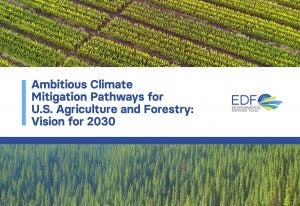Farmers and other agriculture professionals can often seem to be at odds with some environmental groups, especially when the objectives of those groups are beholden to organic-industry funding or rely on sensationalized “science.” It’s frustrating for those connected to modern agriculture because there isn’t a corner of the ag community that isn’t cognizant of land stewardship, environmental impacts, and sustainability. Agriculture as a whole has done more than most American industries to improve its carbon footprint in relation to shrinking land and labor resources.
The Environmental Defense Fund is one environmental nonprofit that has often wanted to work with farmers, rather than against them, to find climate solutions. This is particularly so with the U.S. committing to cut national emissions in half by 2030, something that can’t be done with continued contributions from agriculture, which currently emits about 11 percent of the country’s annual emissions (well behind transportation at 27 percent and electric power at 25 percent).
Details about how to cut agricultural emissions — without compromising food security or producer livelihoods — have been a bit of a puzzle, especially as farmers and ranchers try to do more with less land, fewer workers, and just a standard 24 hours in a day.

A new Environmental Defense Fund report titled, Ambitious Climate Mitigation Pathways for U.S. Agriculture and Forestry: Vision for 2030, offers a bold but achievable roadmap for how farms, ranches, and forests can get the U.S. 17 percent of the way toward its 2030 goal.
The report sets the first science-based targets for reduced emissions from U.S. agriculture and increased carbon storage from U.S. forestry, and identifies the most impactful, lowest-cost pathways to achieve those targets. By 2030, the findings suggest that U.S. farms and ranches can cut agricultural emissions by 23 percent, while U.S. forests can boost carbon storage by 43 percent.
The four biggest agriculture and forestry climate opportunities the report identifes are:
- Cutting agricultural methane emissions 25 percent by 2030 by changing how much methane cattle burp as they digest food and improving the way manure is stored.
- Cutting agricultural nitrous oxide emissions 9 percent by 2030 by optimizing fertilizer use on cropland.
- Cutting carbon dioxide emissions from land use change 72 percent by 2030 by keeping all existing forests, wetlands, and grasslands intact rather than clearing them for new cropland or urban developments.
- Increasing carbon storage in forests 32 percent by 2030 by reforesting land, improving management of existing forests, and adopting agroforestry practices that integrate trees and shrubs into crop- and pastureland.
“Climate change is already here, making it harder to grow crops and raise cattle in many places. Fortunately, agriculture has two super powers to quickly slow warming this decade: cutting methane from livestock production and nitrous oxide from fertilizer use. These are powerful greenhouse gases that largely determine the rate of climate change we will experience in the near term,” said Amy Hughes, senior manager for Climate-Smart Agriculture at EDF.
» Related: Perspective: Carbon markets can be a good thing for farmers and ranchers
The report doesn’t order farmers to go out and get this done; instead, it includes an economic analysis of the technologies and practices to highlight those that could most cost-effectively contribute to the targets. It also recognizes that there is no one-size-fits-all nationwide approach, and that local efforts may vary.
The PDF of the 69-page report can be found here. In an era when it’s sometimes difficult to tell which “environmental” organizations and causes are legitimate and which ones are masquerading as such for publicity and profit, the Environmental Defense Fund has traditionally been thoughtful and respectful of the diversity and nuance in how our food is grown.


